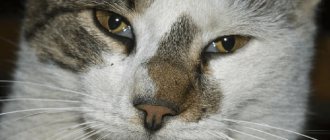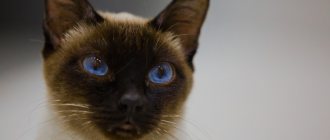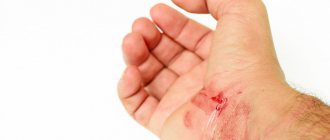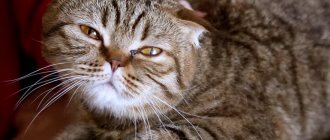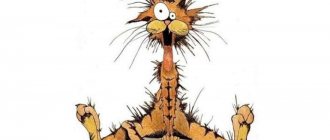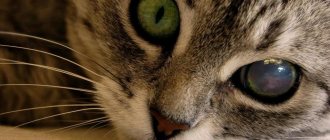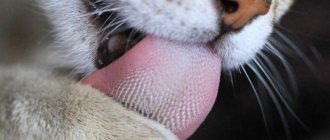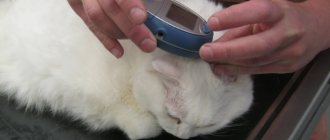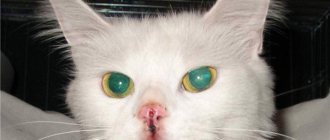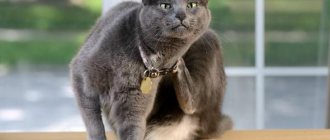Sometimes cat owners find that their pet has one or both eyes partially covered with a grayish film. This is a reason to more carefully evaluate the cat’s well-being and behavior. The third eyelid in a cat is an important part of the auxiliary apparatus of the eye.
In cats, the third eyelid, or nictitating membrane, is a fold of the conjunctiva at the inner corner of the eye. In a healthy cat, the third eyelid is usually practically invisible, and when the eyes are closed, the nictitating membrane covers the entire surface of the cornea, helping to moisturize it.
A visible third eyelid in a cat always indicates certain problems that require diagnosis of the causes of its loss and treatment.
What is the third eyelid in cats?
The so-called “third eyelid” is a fold of the conjunctiva at the inner corner of a kitten’s eye. This organ plays a big role in vision. So, it is he who protects the eye from dust, secretes tear fluid and cleans the membrane from debris and dirt. The Murkoshi team warns that cats in general are prone to diseases of the visual organs, so inflammation of the third eyelid is a fairly common occurrence. Do not be alarmed, because sometimes it is only a consequence of mild infections. However, in any case, you will need to contact a veterinarian, as sometimes it can indicate serious pathologies in the cat’s body!
Causes
Prolapse of the third eyelid in a cat can occur for a variety of reasons. As we wrote above, sometimes it can become an indicator of harmful diseases or infections in the furry body. A kitten's third eyelid can be a genetic feature (especially common in Persian and British cats), an allergy, or a reaction to something getting into the eye. Let's figure it out.
1. Allergy (allergic conjunctivitis) A reaction can occur to anything. Thus, household chemicals, food, and pollen can cause a third eyelid to appear in a cat. Even a banal decrease in immunity can cause such a reaction. However, it is impossible to accurately determine the cause of the disease without the help of a veterinarian.
2. Infections and parasites Do not write off various types of infections, from viral to bacterial. Chlamydia, mycoplasmosis, etc. can cause inflammation of the cat's third eyelid. In addition, the cause of this disease can be parasites, whose larvae are often carried into the house on shoes or clothes from the street. Read about the main infections in cats: What are the types of infections in cats and how to treat them
3. Adenoma Another common disease is adenoma of the third eyelid in cats. This is a benign tumor caused by disruptions in the hormonal background of a cat (especially a thoroughbred like a Persian or Exotic), injuries or the same infections. The worst thing you can do if you discover an adenoma in your cat is to let the situation go and expect it to go away on its own. This disease is constantly evolving and can lead to other infections entering the cat’s body through it.
4. Diseases of internal organs Inflammation of the third eyelid in a cat can be a consequence of such serious diseases as renal failure, disturbances in the gastrointestinal tract, diarrhea, and so on. In this case, this same inflammation is also a kind of allergic reaction to substandard processes occurring in the body.
5. Eye injury One of the most common causes of third eyelid prolapse in cats. Your pet could have scratched this part of the eye on something; a speck or grain of sand could have gotten in there. However, the need to contact a veterinarian does not become less, since in any case surgical or medicinal intervention will be necessary.
6. Genetic predisposition Pedigree cats (like dogs) very often have a tendency to a certain type of disease. Thus, inflammation of the third eyelid is common among Persian and British breeds.
Diseases of the nervous system accompanied by prolapse of the third eyelid
If prolapse of the third eyelid is accompanied by a narrowing of the pupil of the same eye, drooping of the upper eyelid, and an apparent decrease in the size of the eyeball, this is a reason to show the cat to a neurologist as soon as possible, since the complex of these symptoms (Horner syndrome) often indicates damage to the nervous system. The reasons for such a lesion may be different; in some cases, in addition to a neurological examination and routine tests, additional diagnostics are necessary - CT, MRI, and some others.
Consequences of inflammation of the third eyelid in a cat
As we already wrote above, inflammation of the third eyelid in a kitten or adult cat is often not an independent phenomenon, but a consequence of more serious pathologies in the animal’s body. Thus, if not treated in a timely manner, other diseases can go unnoticed and lead to truly tragic consequences, including death. Moreover, if the disease of the internal organs is really serious and poses a danger to the furry one.
In case of an allergy, it will be necessary to get rid of the pathogen as soon as possible, because if your cat is still prone to such a reaction to allergens, further interaction with it will have an even more detrimental effect on the pet and will cause swelling in other parts of the body.
Adenoma requires surgical intervention, since its further development will contribute to the entry of harmful infections into the body.
Eye injury (mechanical) is no less dangerous for babies than adenoma, since both of them can lead to blindness of the eye on which the kitten’s third eyelid is inflamed. While they are not yet adult cats, their immunity is significantly weakened and is unable to fight such diseases on its own. Therefore, if inflammation is detected, you should immediately contact a specialist.
Fungal infections are also dangerous for cats and can lead to a variety of consequences: from hair loss to serious changes in the functioning of the animal’s organs.
Read more: What are fungal diseases in cats?
Organ structure
As numerous photos show, the nictitating membrane on one side is adjacent to the cornea. On the other, to the upper and lower eyelids, to their inner surface.
The inner part of the membrane is covered with lymphoid tissue, which can be mistakenly mistaken for the focus of the inflammatory process of a disease such as, for example, follicular conjunctivitis. When it is removed, the protective function is weakened.
The eyelid maintains its shape thanks to cartilage. It emerges from the medial angle, while promoting the tightest possible fit of the membrane to the cornea. Its base is surrounded by tear-producing tissue. It is attached by soft ligaments to the periosteum of the skull.
Functioning of the membrane
The membrane functions involuntarily. The cat alone will not be able to make the transparent shell move. The eyelid begins to move forward when the head is lowered or during irritation of the cornea. The membrane slides smoothly over the cornea, disinfecting the surface with tear fluid.
Regardless of its functions, the eyelid can have some pathologies that will negatively affect the health of the cat.
Pathologies
There are some breeds of cats that can experience prolapse or protrusion of the nictitating membrane. This is most dangerous in the period from 2 to 9 months of life. Due to constant blinking, an enlarged eyelid can become injured.
Due to its large size, the membrane will come into contact with the cornea, creating discomfort for the pet. The situation will become more complicated if the fluffy starts rubbing his eyes on his own. The video will show you what complications associated with third eyelid prolapse look like.
Treatment
There are two ways to treat inflammation of the third eyelid in a kitten or cat: surgical and medicinal. “Murkosha” draws your attention to the fact that both methods are prescribed by a veterinarian, and does not recommend self-medication, because it can lead to even more harmful consequences than the development of the disease itself!
As a rule, specialists prescribe drops and ointments for the eyes, because they contribute to the fastest recovery. So, the most common drops are Bars, Tsiprolet, Iris, Levomycelin. These often include antibiotics to combat any further signs of inflammation. If your pet's third eyelid is swollen due to contact with parasites, then you must take antihistamines and treat the cat against ticks and fleas.
Read more: How to treat a cat for parasites
It is also worth carefully examining your pet’s skin and mucous membranes for symptoms of fungus, and purchasing appropriate medications if symptoms of infection are detected. Pay special attention to your pet's diet and the amount of necessary vitamins in it. Inflammation of the third eyelid in a cat can also be treated with dietary food if it appears as a result of malfunctions of the internal organs. However, treatment methods in this case are individual, and consultation with a specialist is necessary.
Therapy methods
Treatment at home is carried out as prescribed by a veterinarian.
For infectious pathologies, antibiotics are used, and antibacterial agents can be used.
Identified corneal ulcers and glaucoma require surgical intervention. Often, for glaucoma, complete removal of the eye is performed.
Excision of corneal ulcers is a less painful procedure. During this procedure, only the affected tissue is removed. After the procedure, scars remain that prevent full restoration of vision.
Therapy is carried out using non-steroidal anti-inflammatory drugs. The drugs have an impressive list of contraindications and, with prolonged treatment, can negatively affect the general condition of the animal .
For any pathologies, it is recommended for the cat to drip antiseptic drugs and apply medicinal ointments. At the same time, the affected organ is moisturized.
With timely treatment, it is possible to prevent the penetration of pathogenic microorganisms.
The cat needs to create comfortable conditions. He needs rest and diet.
Sometimes complex therapy is used:
- use of Gamavit and Tetracycline ointment;
- washing the organ with Metrogyl solution;
- use of drugs containing Actovegin;
- prescription of antiviral drugs.
Traditional methods of treatment
Traditional medicine should be used carefully. It is advisable to consult a veterinarian before starting therapy.
The following remedies will help alleviate your pet's condition:
- Tea. 1 tbsp is poured into a glass. dry tea leaves, pour boiling water. Use after completely cooled.
- Elder. To prepare the medicine, 1 tsp. elderberries are poured with boiling water (0.5 cups). Let the liquid infuse for about an hour and filter.
- Celandine. Five leaves pour 2 tbsp. boiling water The liquid is infused for half an hour, then filtered.
- Calendula: 2 tbsp. raw materials are poured with a glass of boiling water, left for a quarter of an hour, filtered.
- Aloe. Three leaves are crushed in a blender, the juice is filtered using gauze.
Medicines are used as follows:
- moisten a cotton pad in the liquid and move it from the outer corner to the inner one;
- change the cotton pad after each wipe;
- both eyelids are treated.
Prevention
Prevention of inflammation of the third eyelid in cats is quite simple and largely coincides with methods of preventing any other diseases. Thus, “Murkosha” strongly recommends keeping your pets at home. Otherwise, the risks of infection through parasites and the appearance of pathologies of the skin and internal organs increase significantly.
Read more about the dangers of the street: Self-walking - when freedom means death
The next thing a cat owner should pay attention to is the pet’s diet and living conditions. Remember that they are living beings just like us, so cats also need to live in comfortable conditions with optimal temperature, cleanliness and humidity. Make sure that the food is suitable for your pet in terms of the ratio of vitamins and nutrients. In addition, you should not feed an adult cat with kitten food or a pregnant cat with food for sterilized individuals.
It is worth paying special attention to the treatment of furry animals from parasites, because they are the carriers of dangerous diseases and infections. And, of course, don’t forget about vaccinations! This is the most important aspect of protecting an animal from many diseases and infections, so “Murkosha” strongly recommends visiting veterinary clinics on time and not sparing money on quality medications. Remember that the health of your pet is entirely in your hands and its life depends only on your actions!
